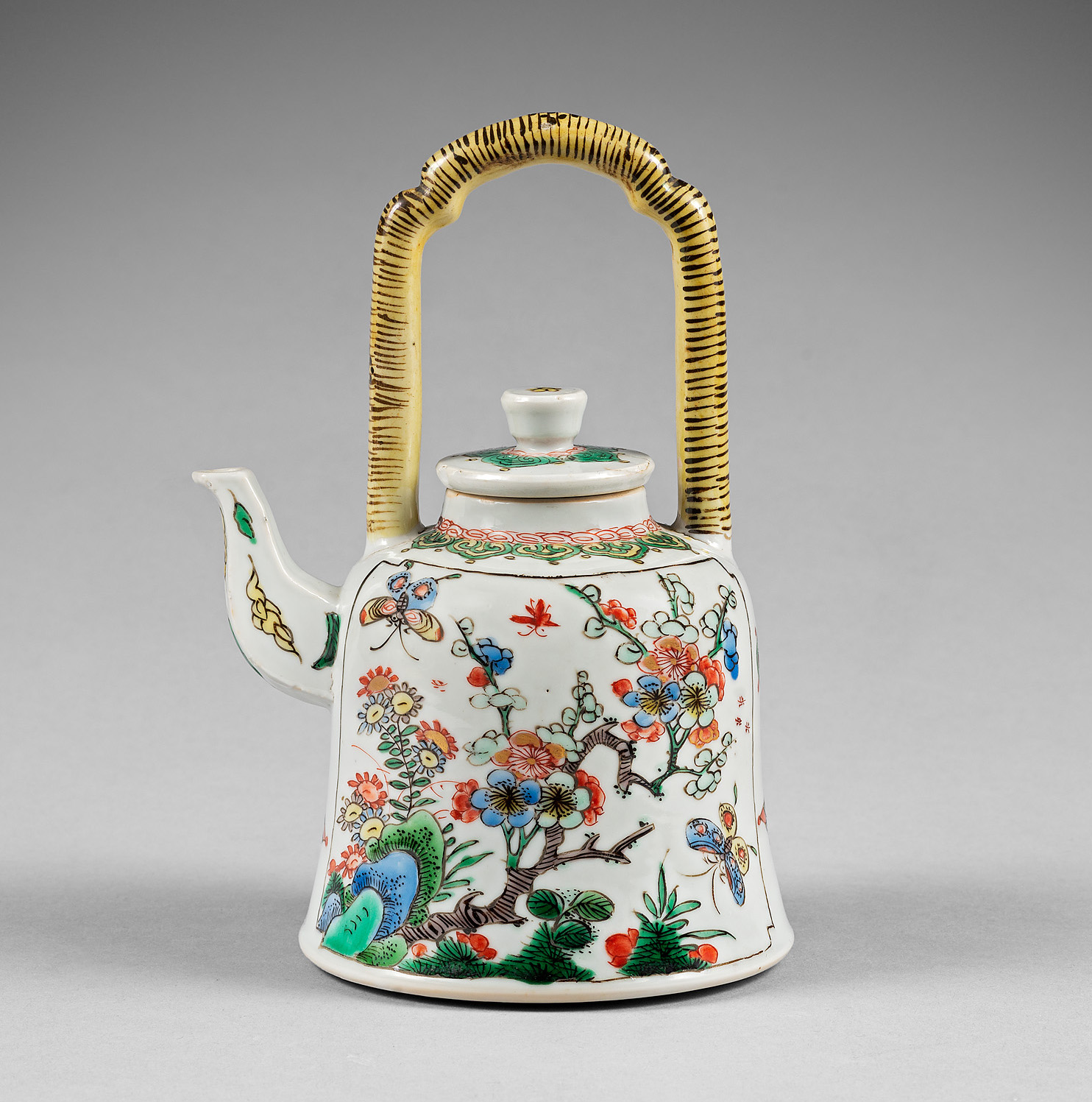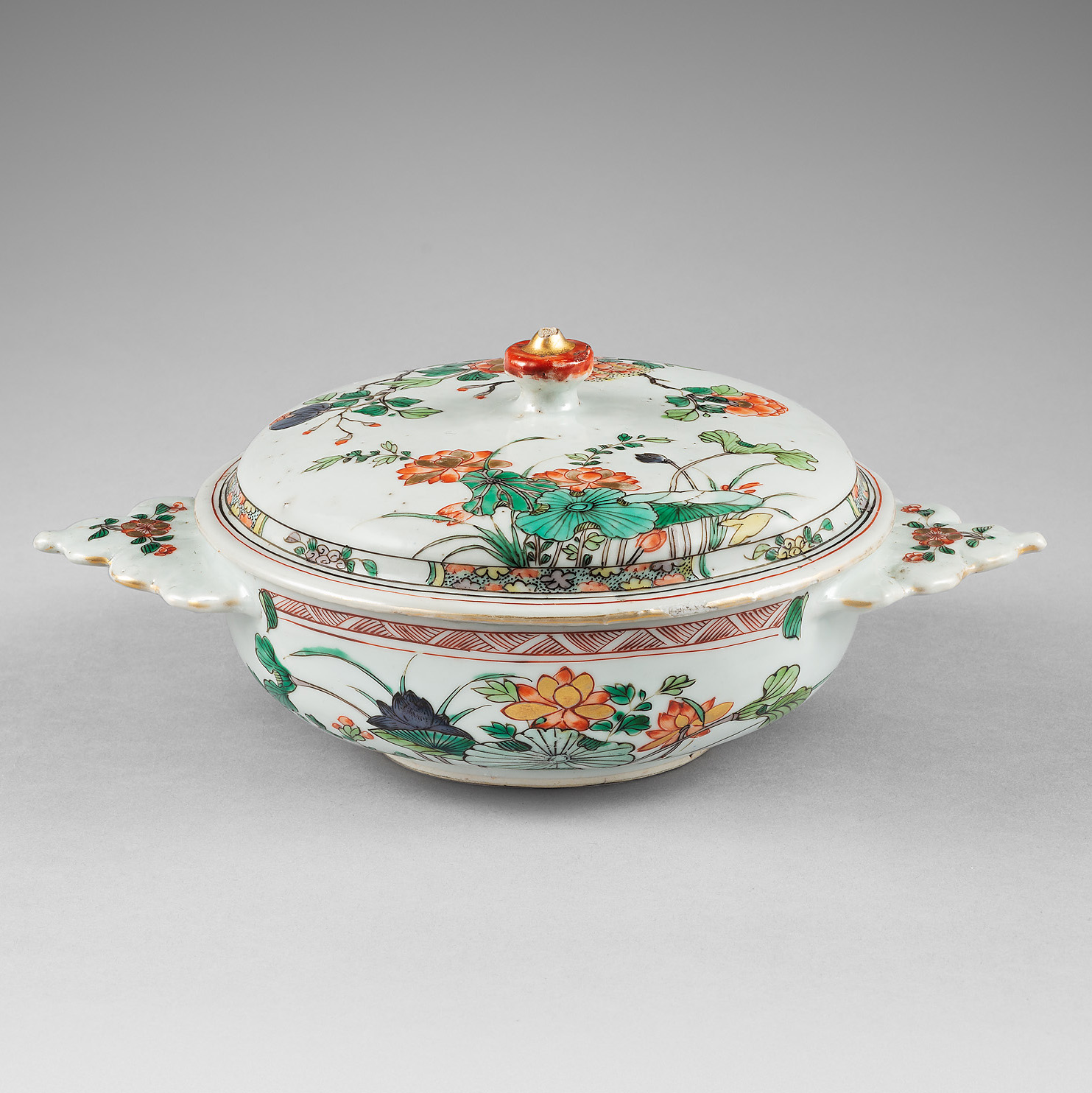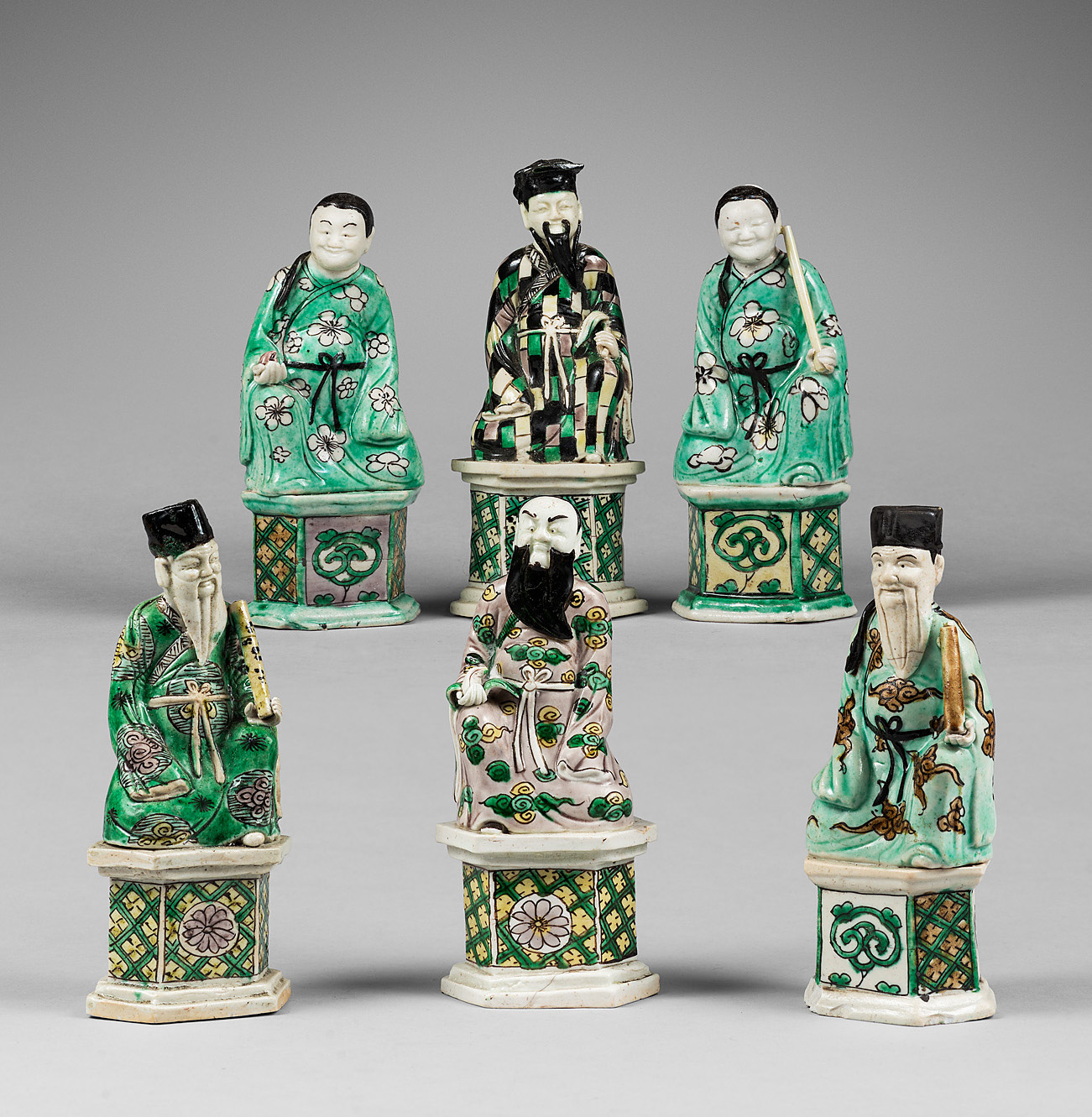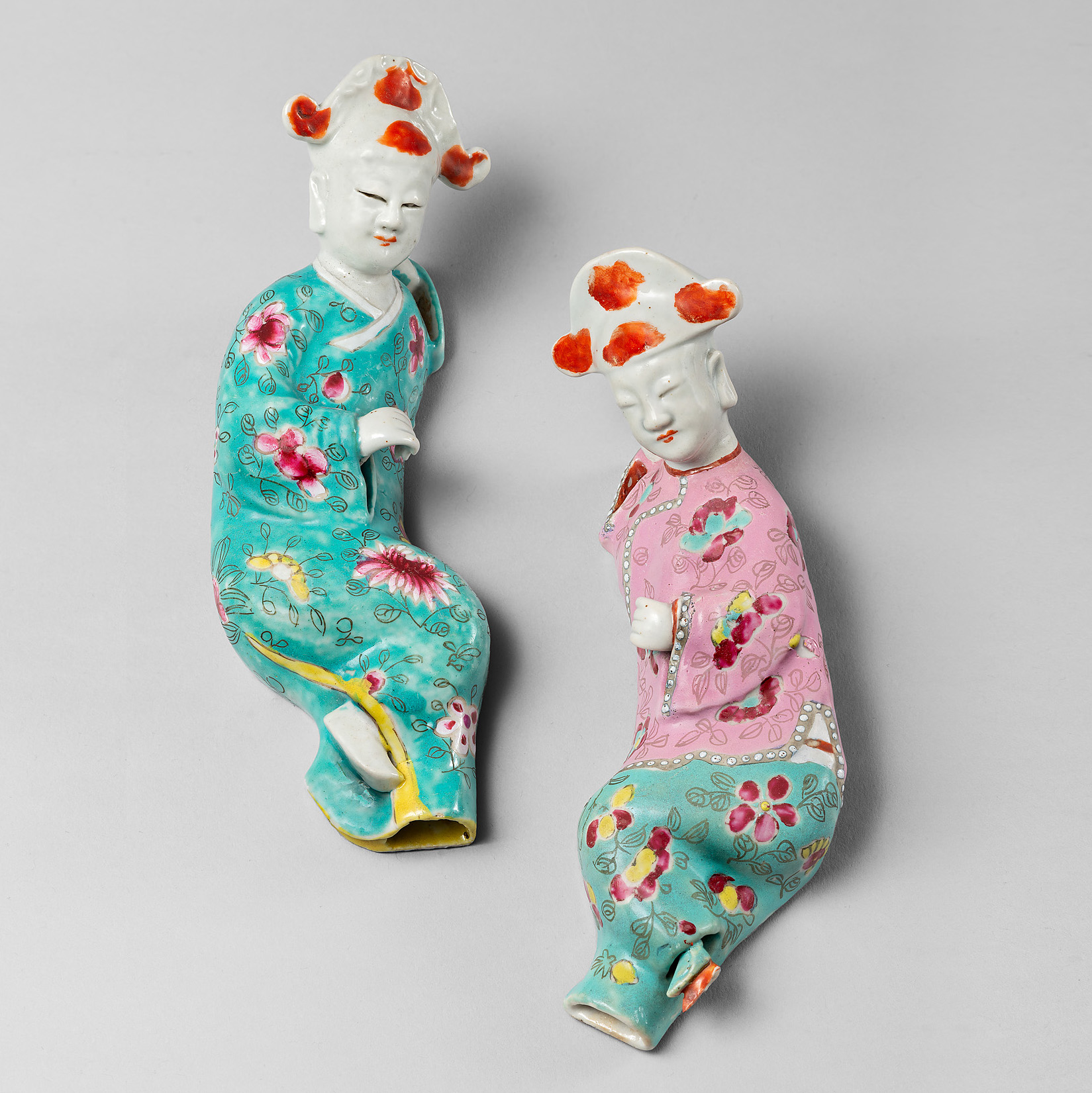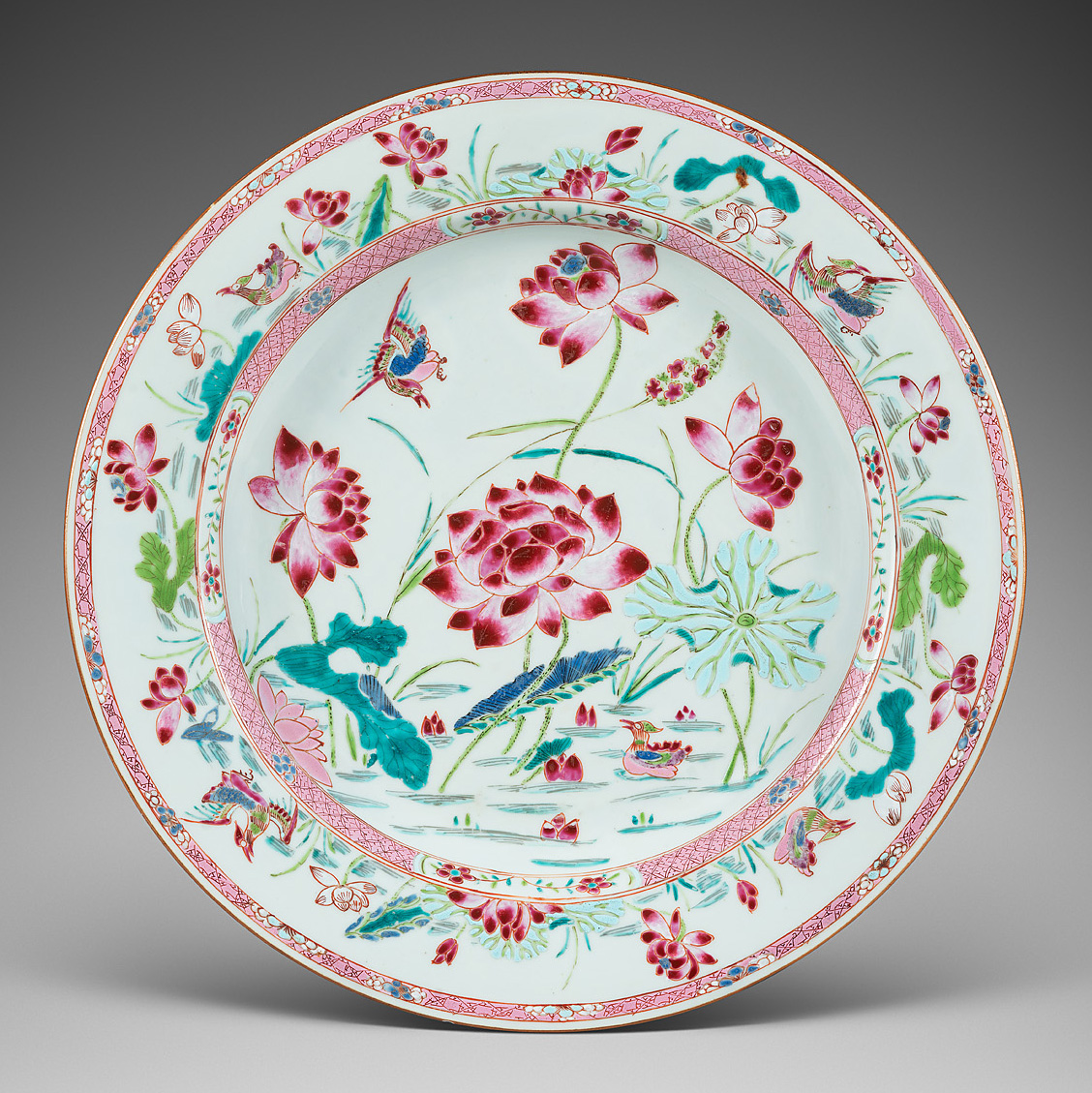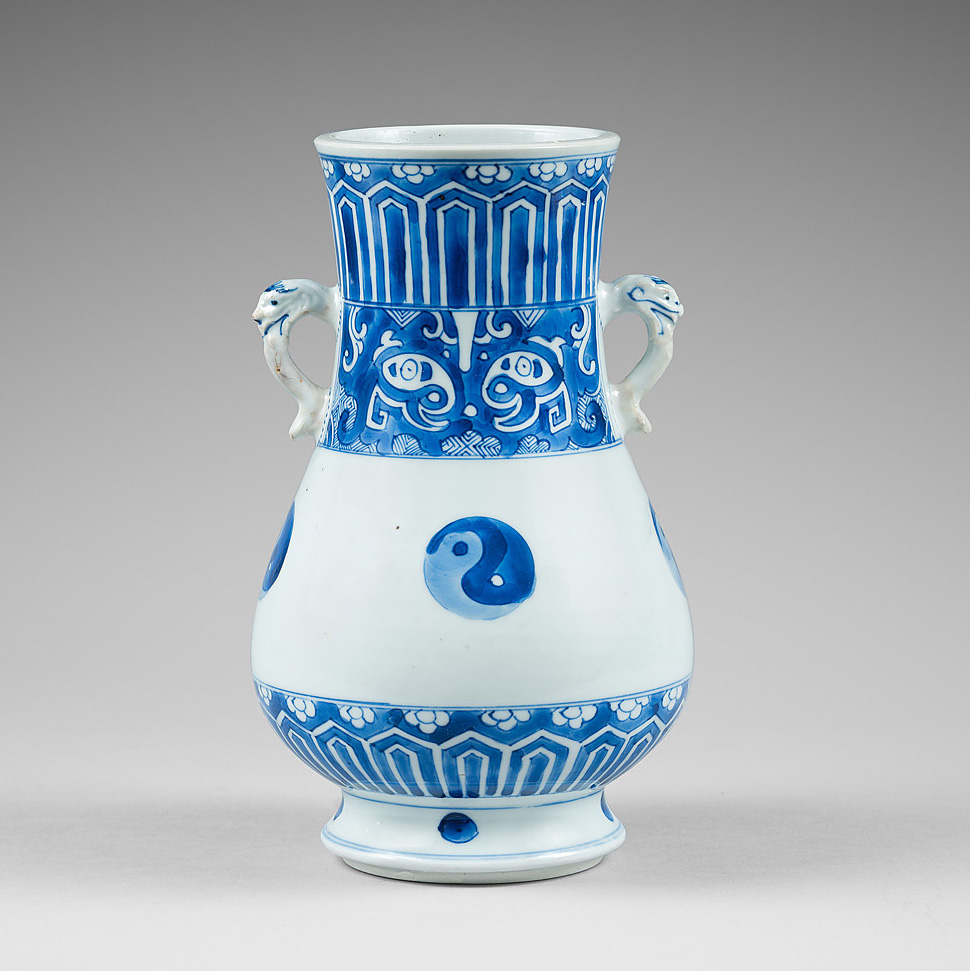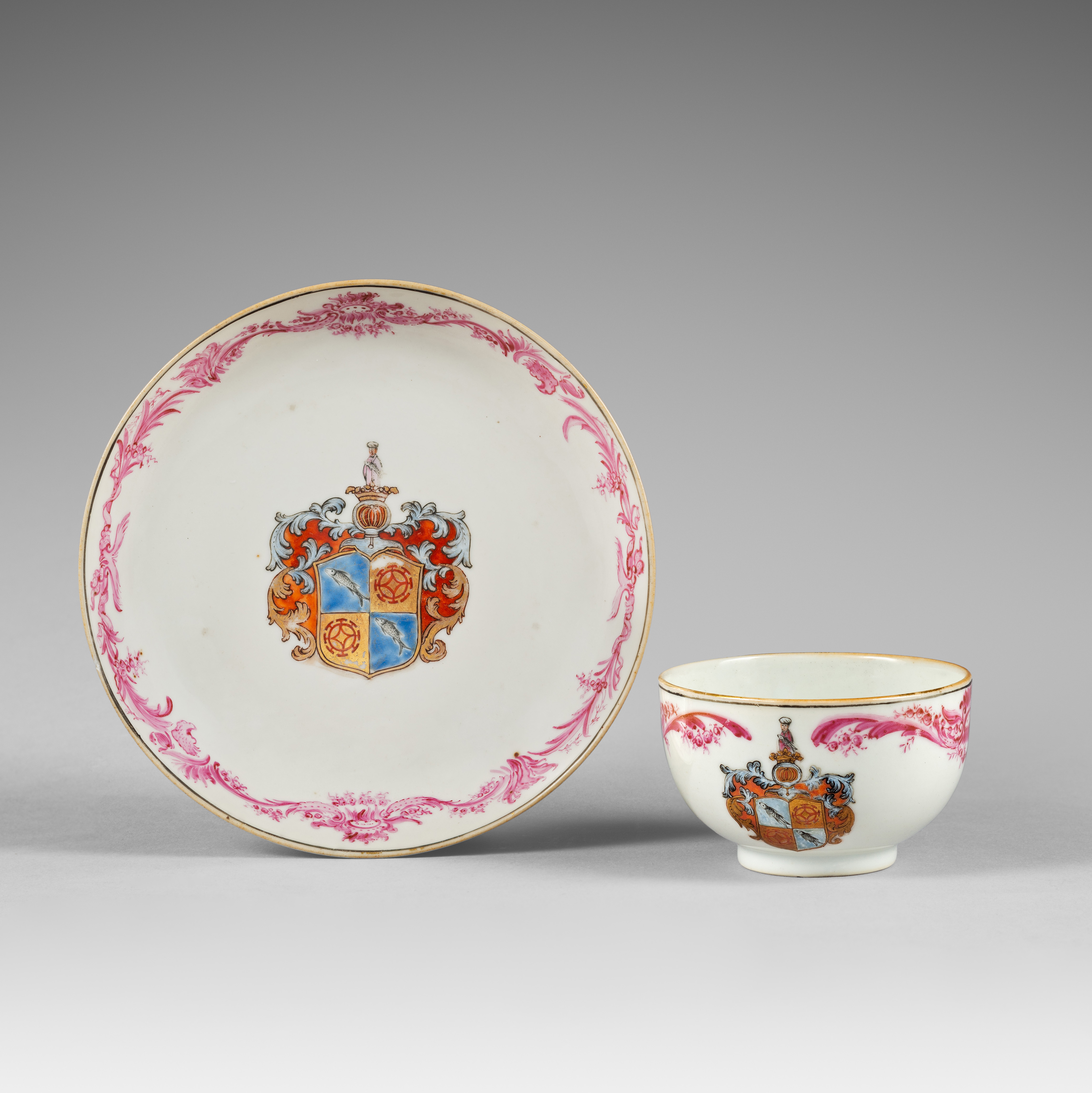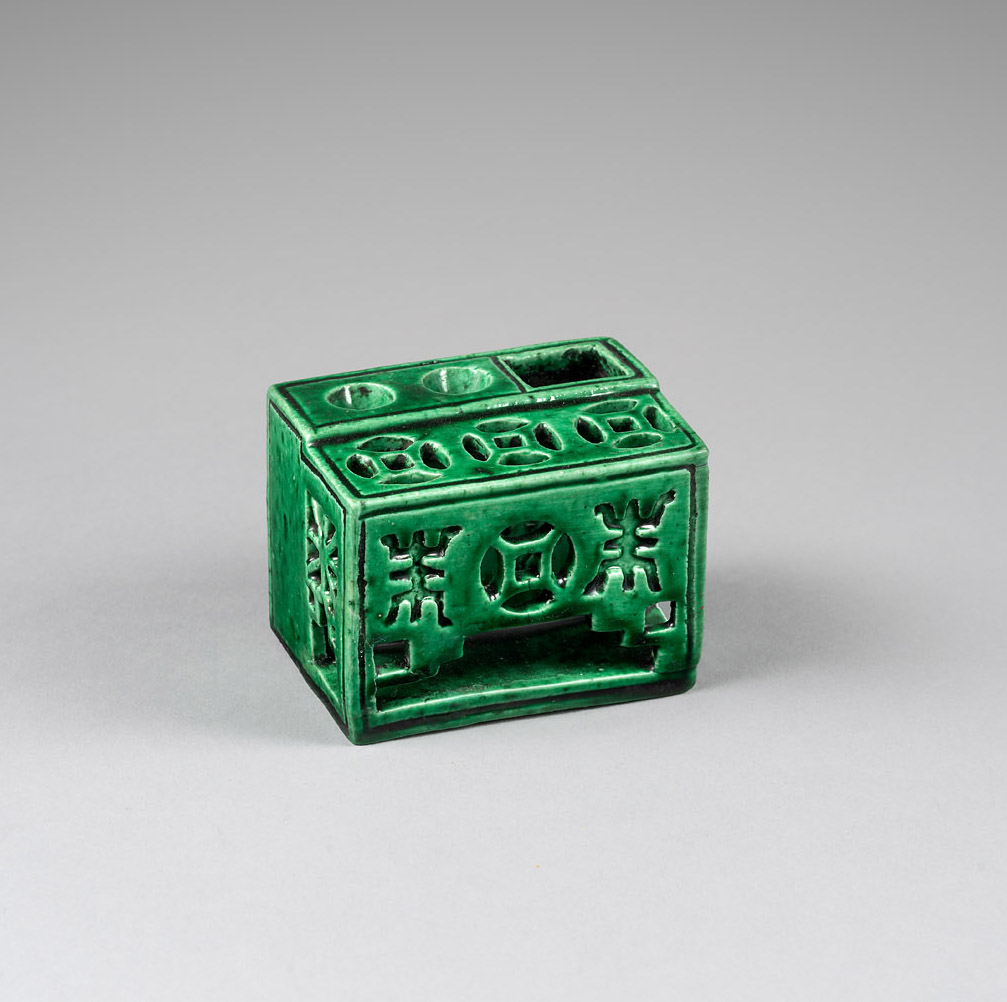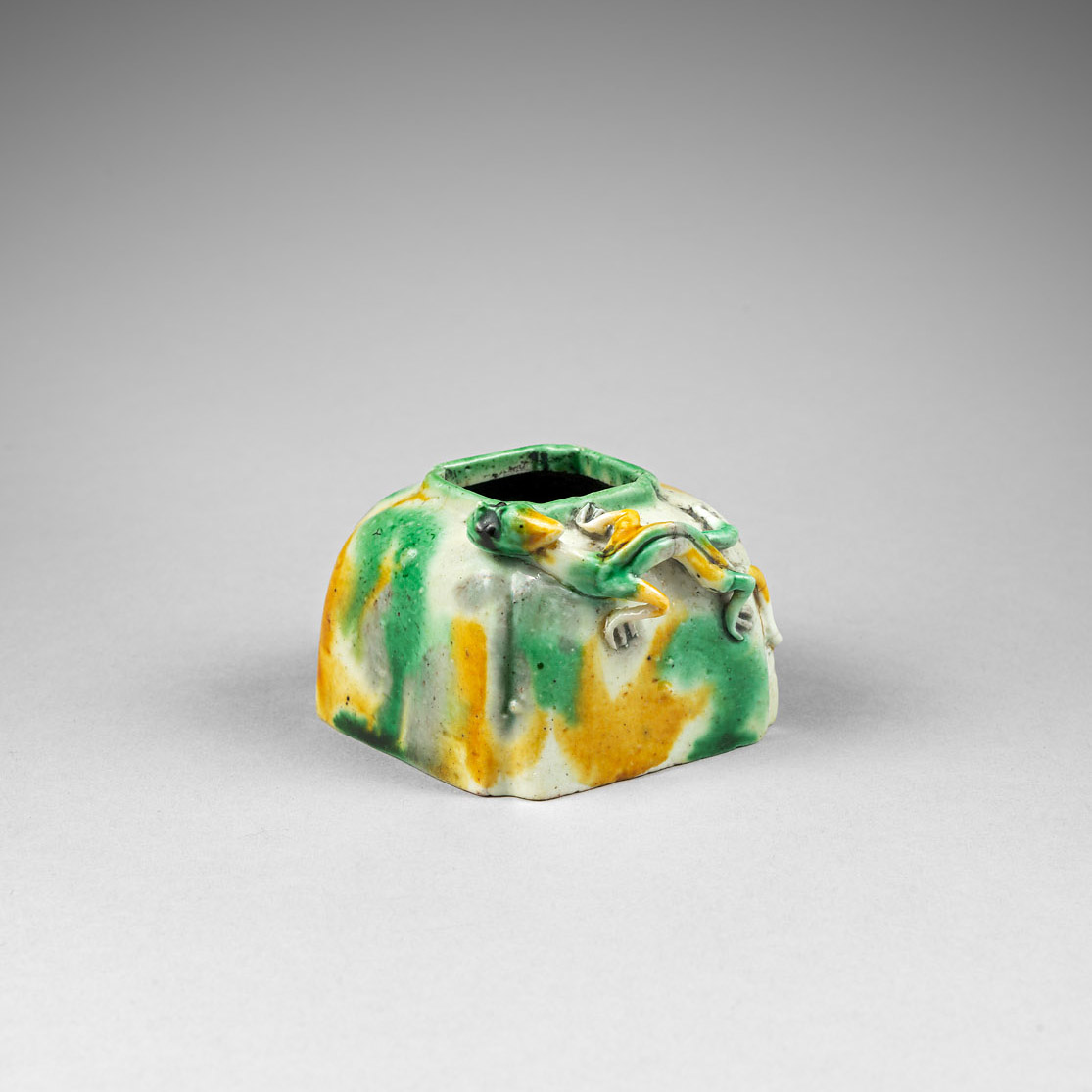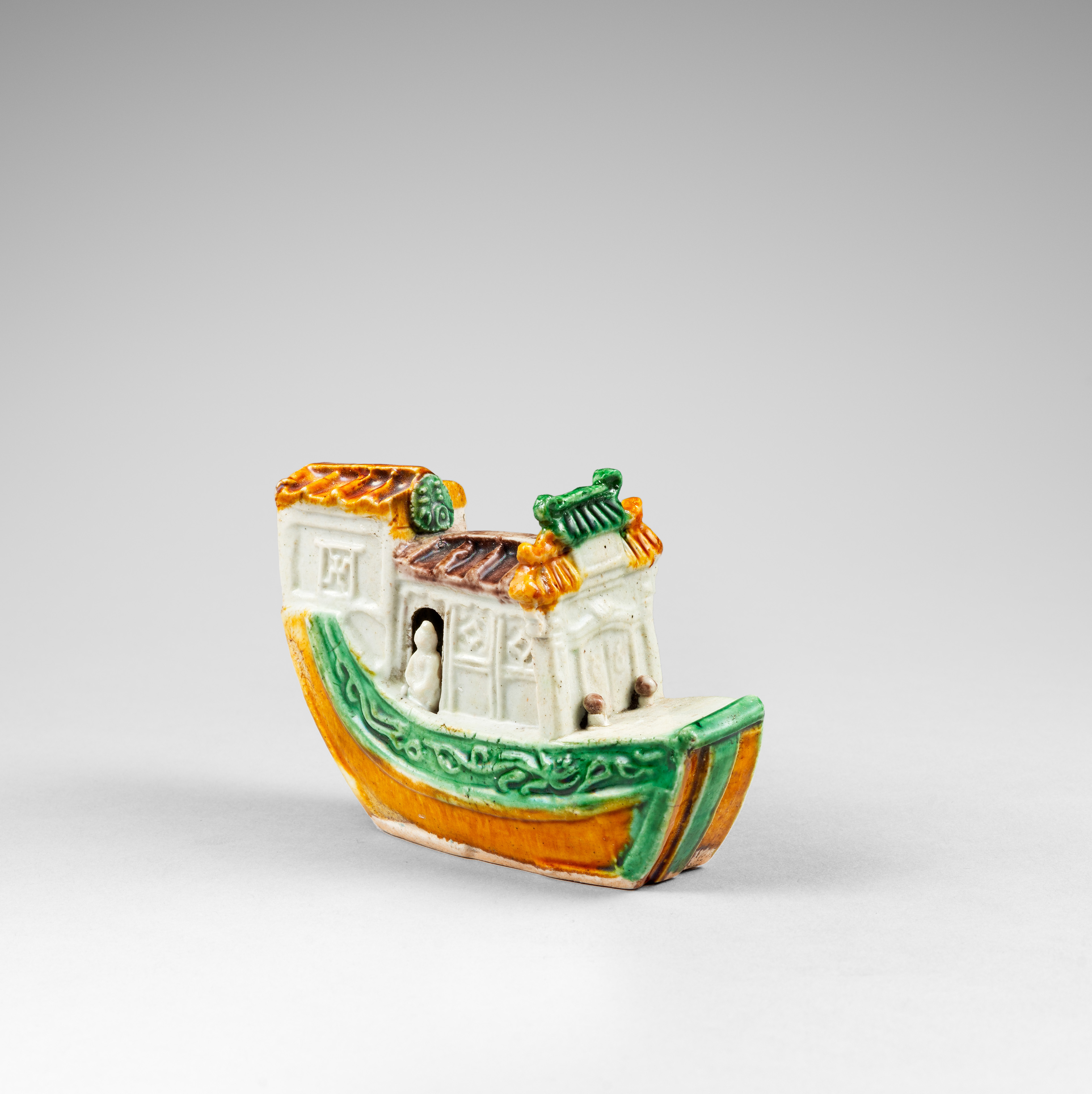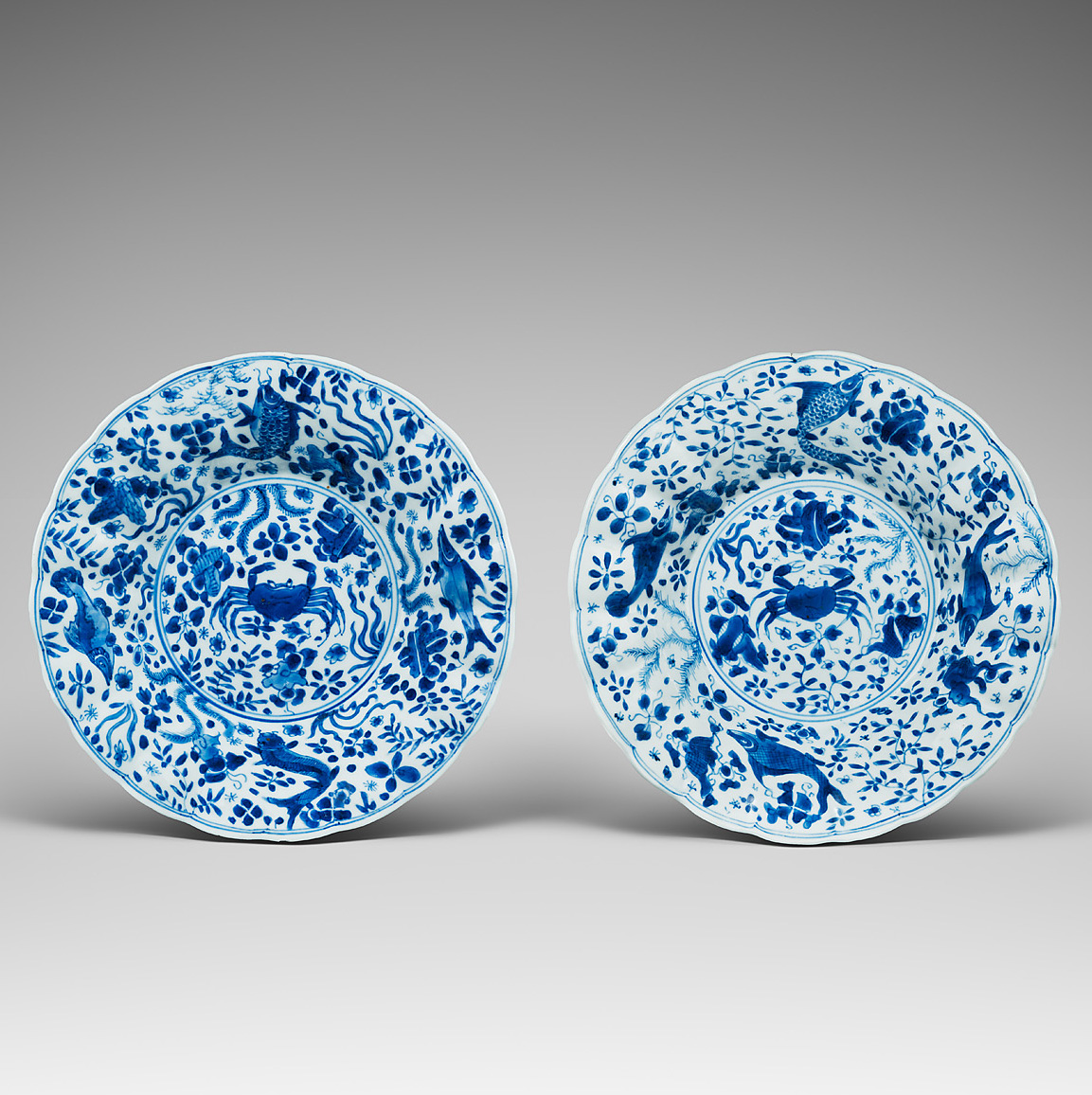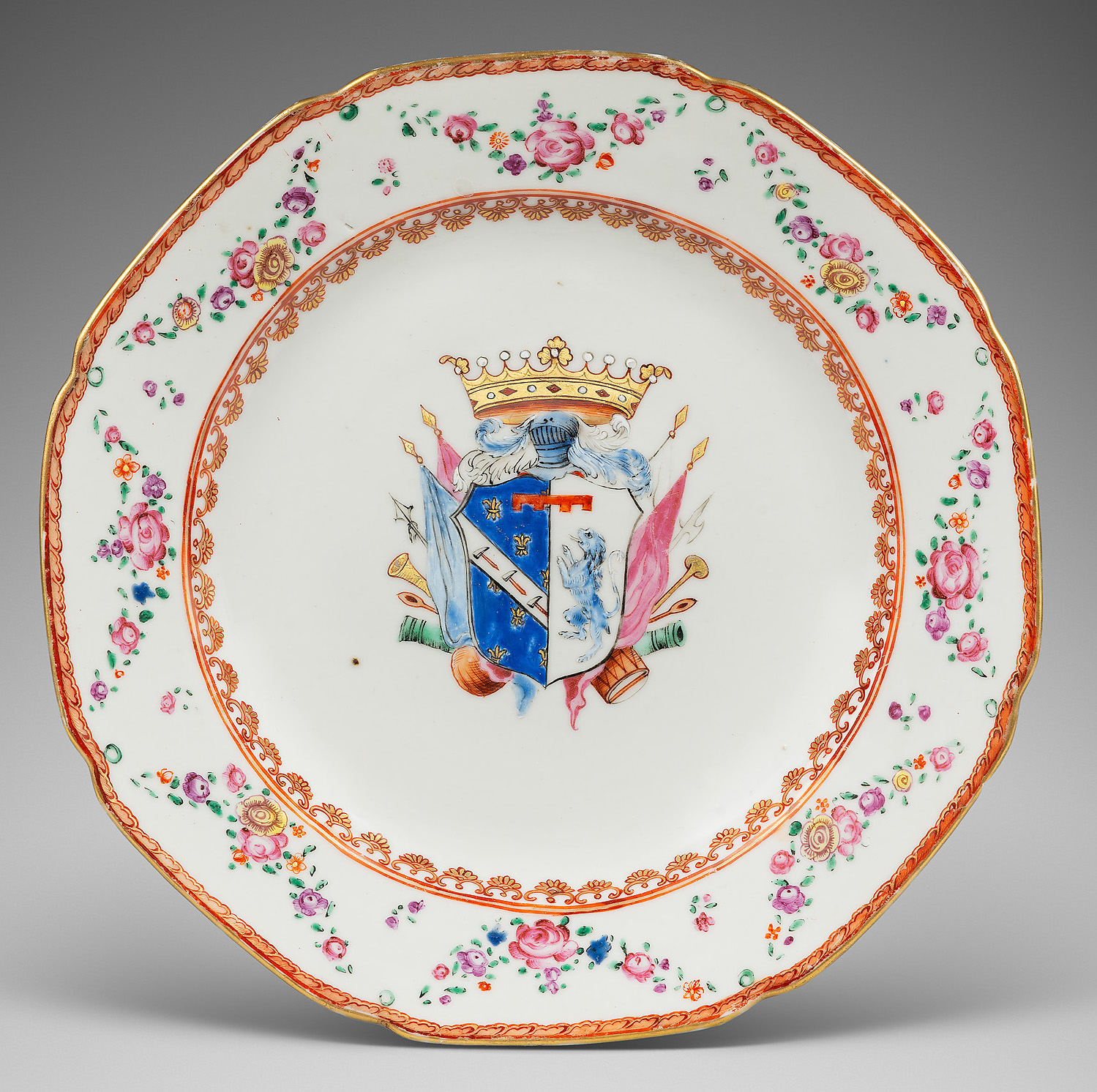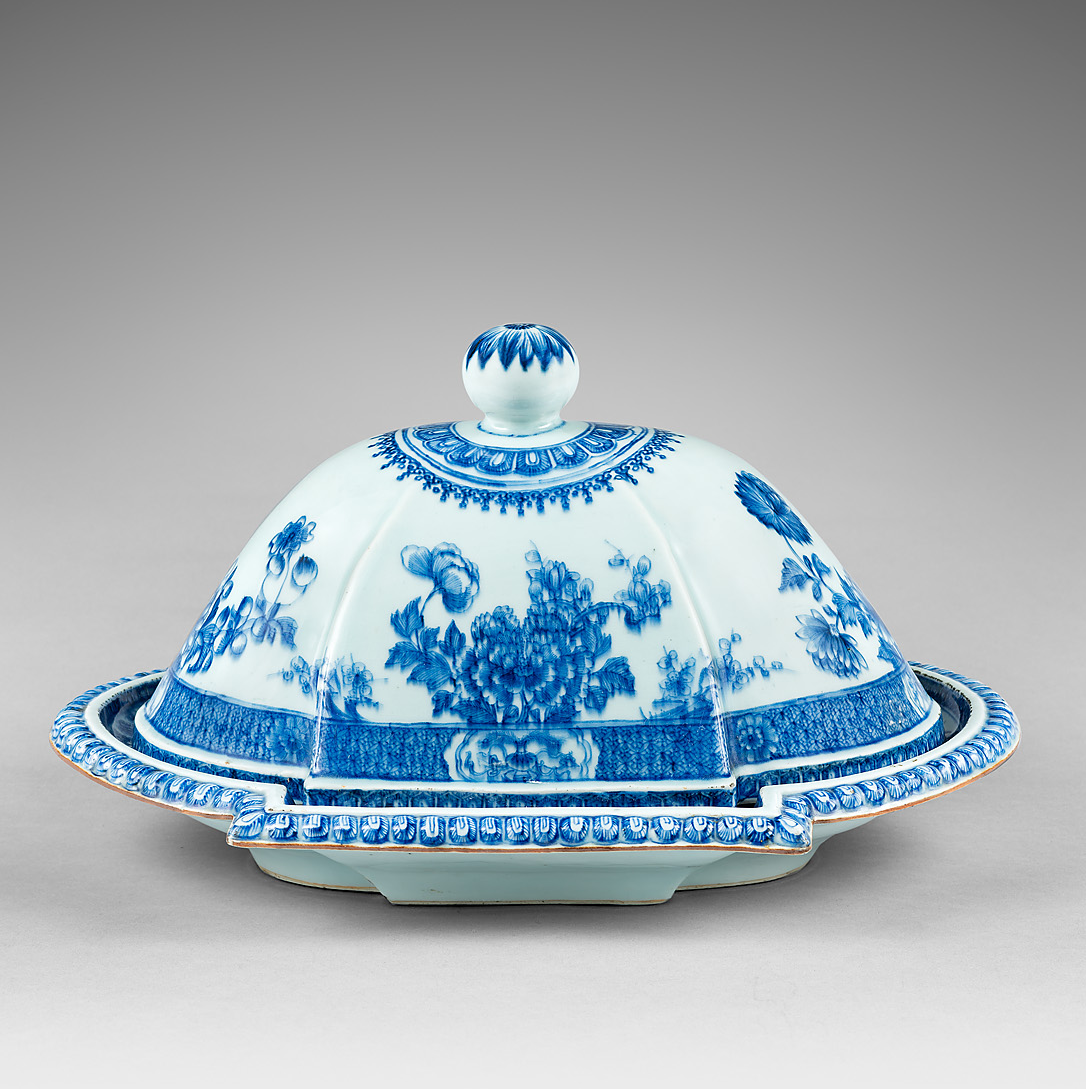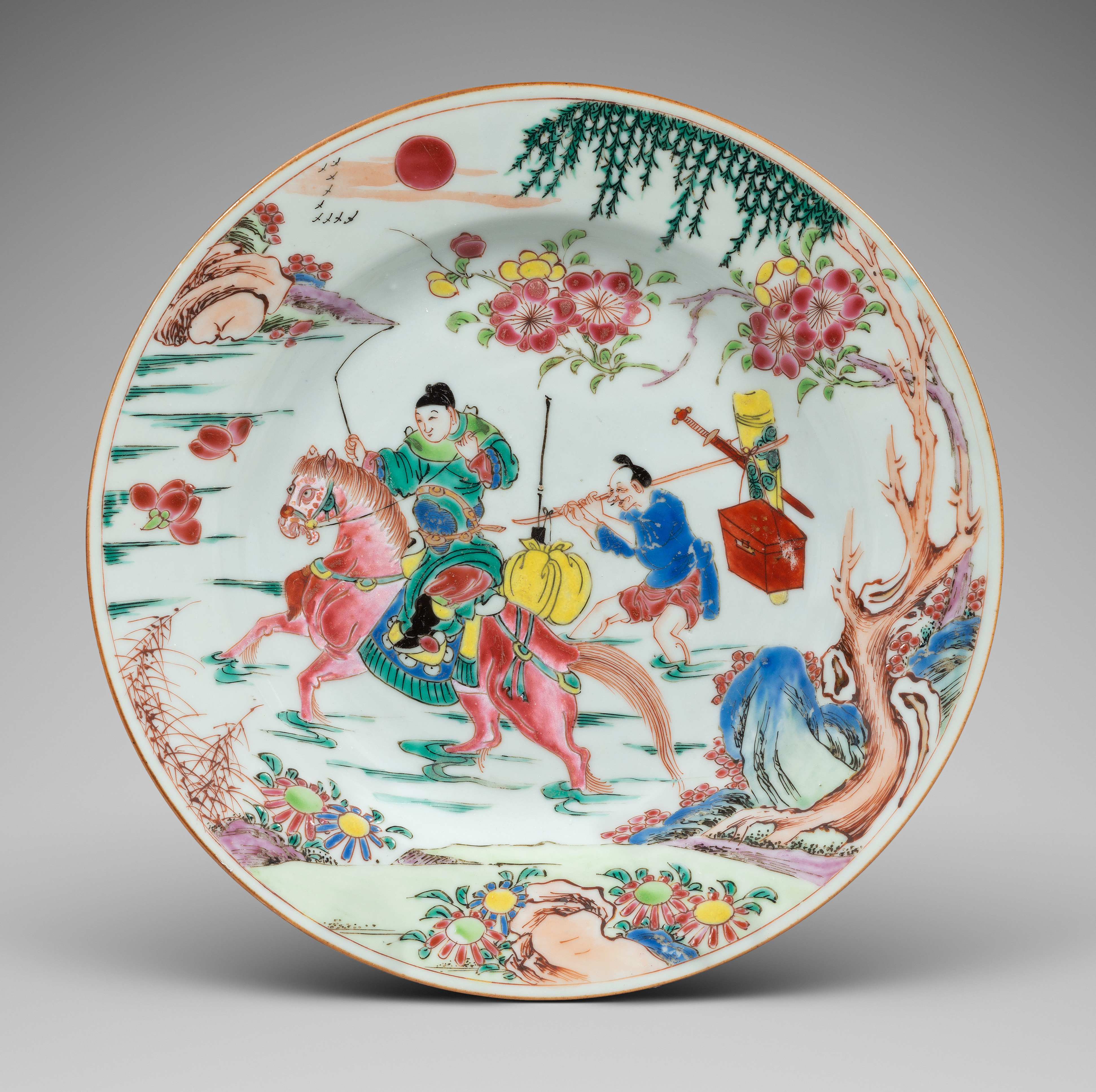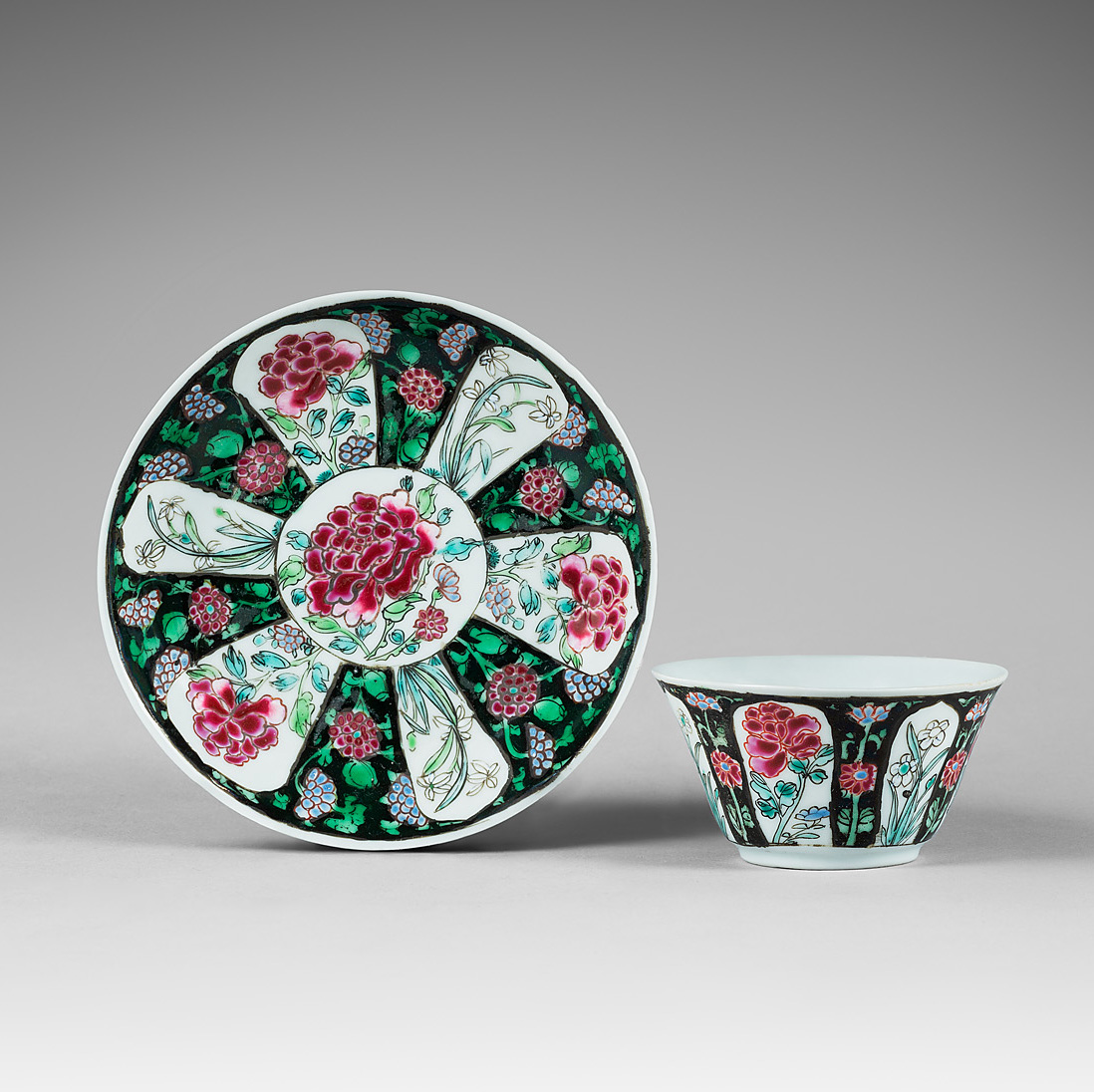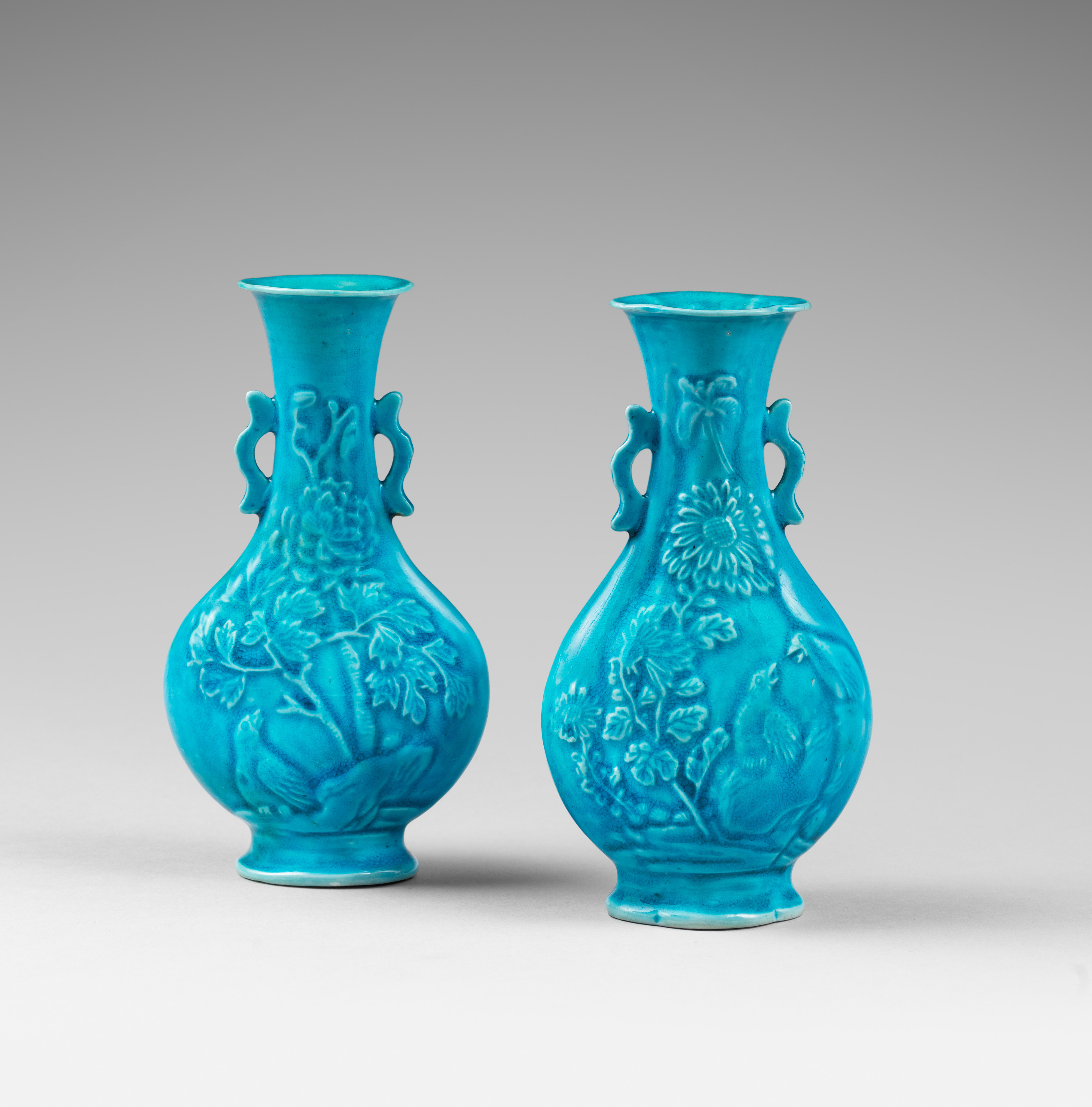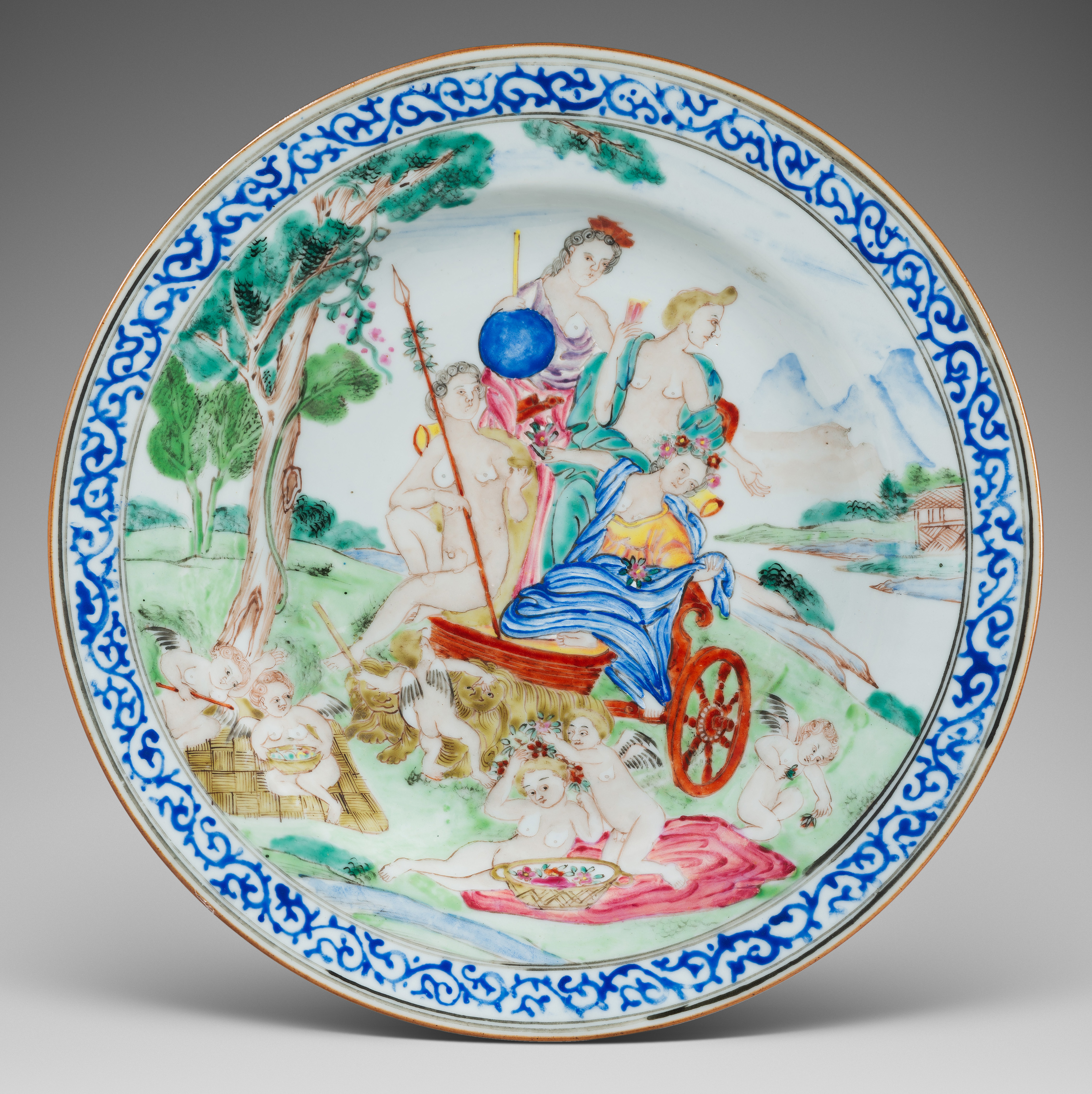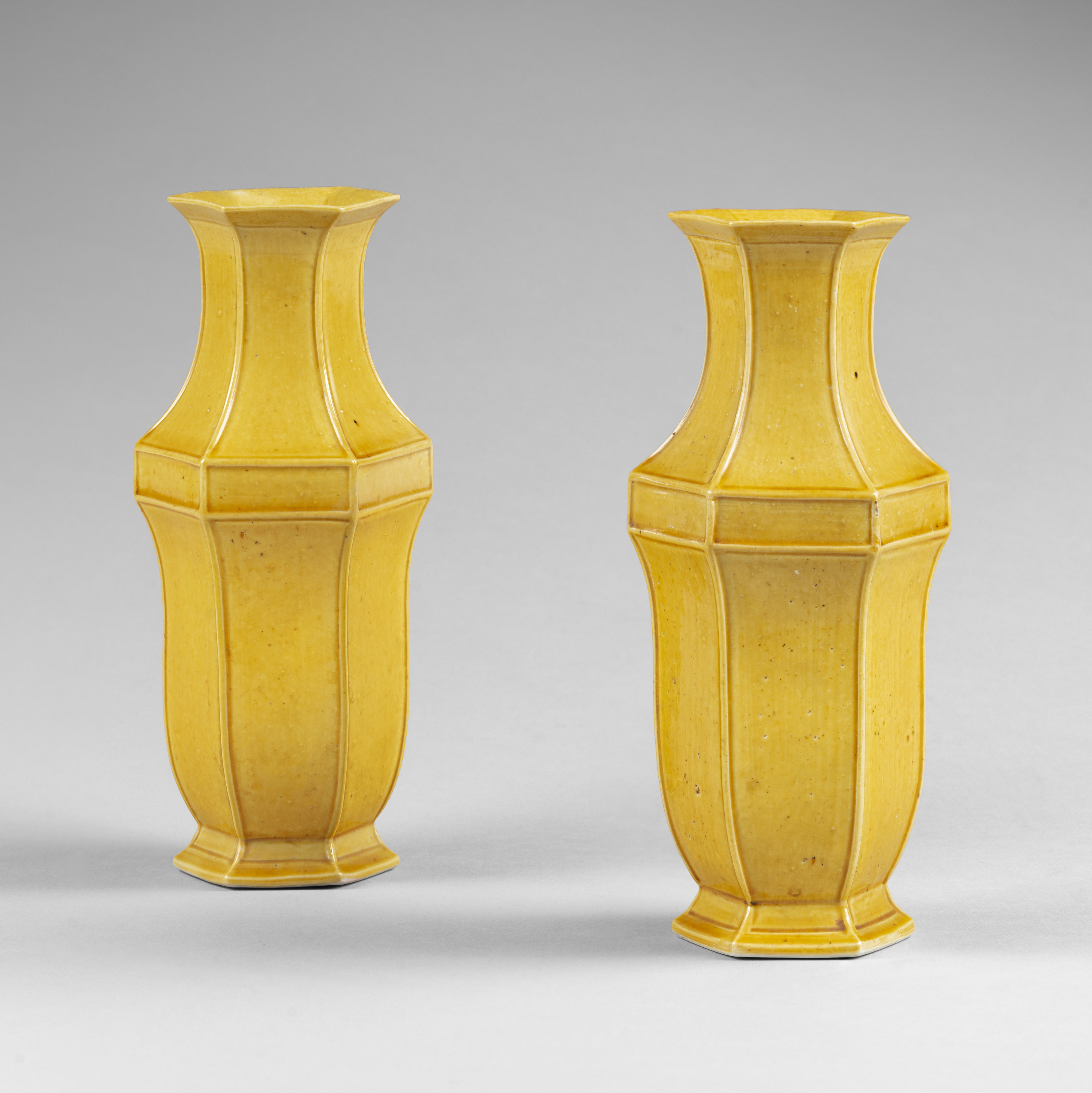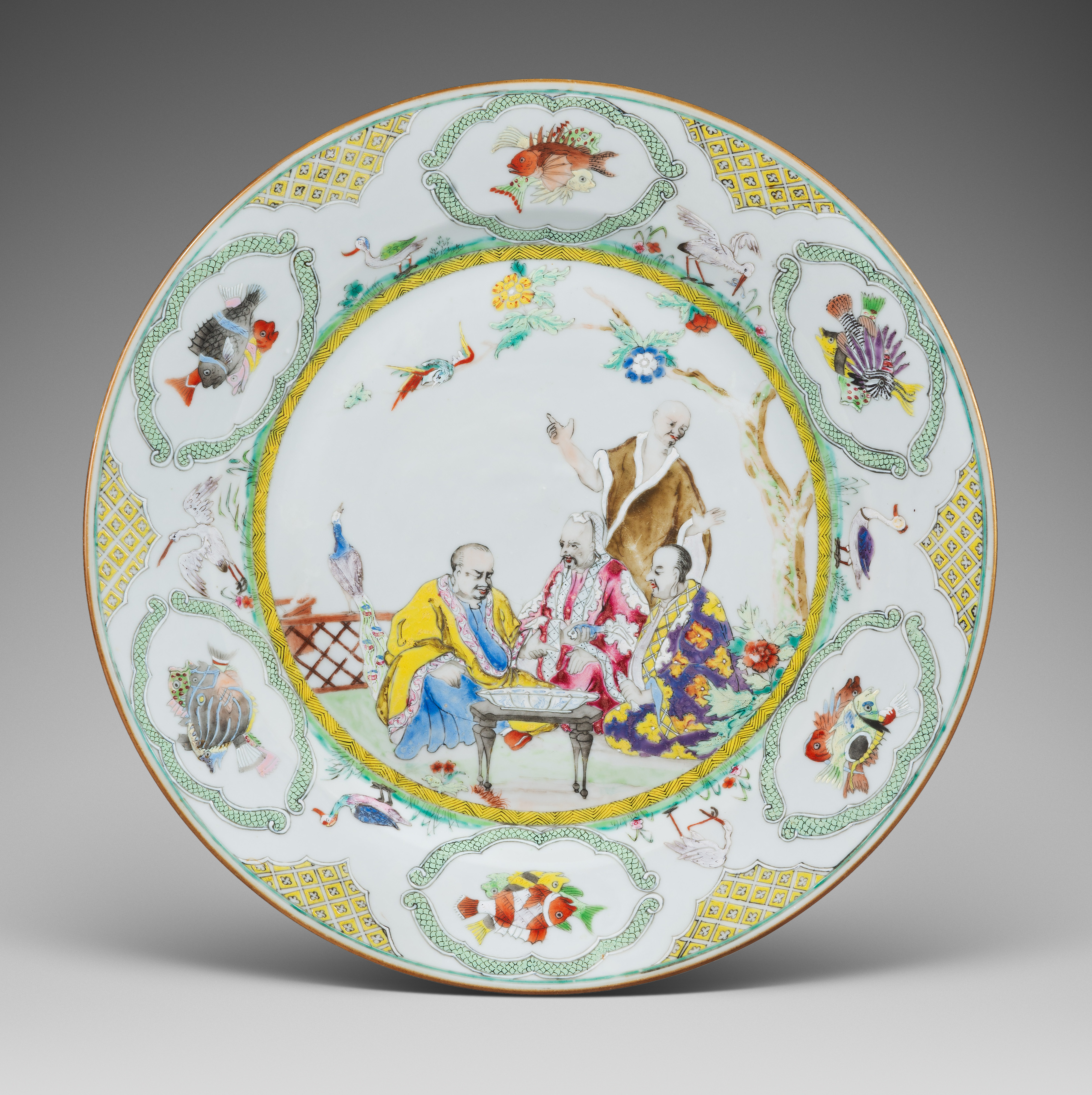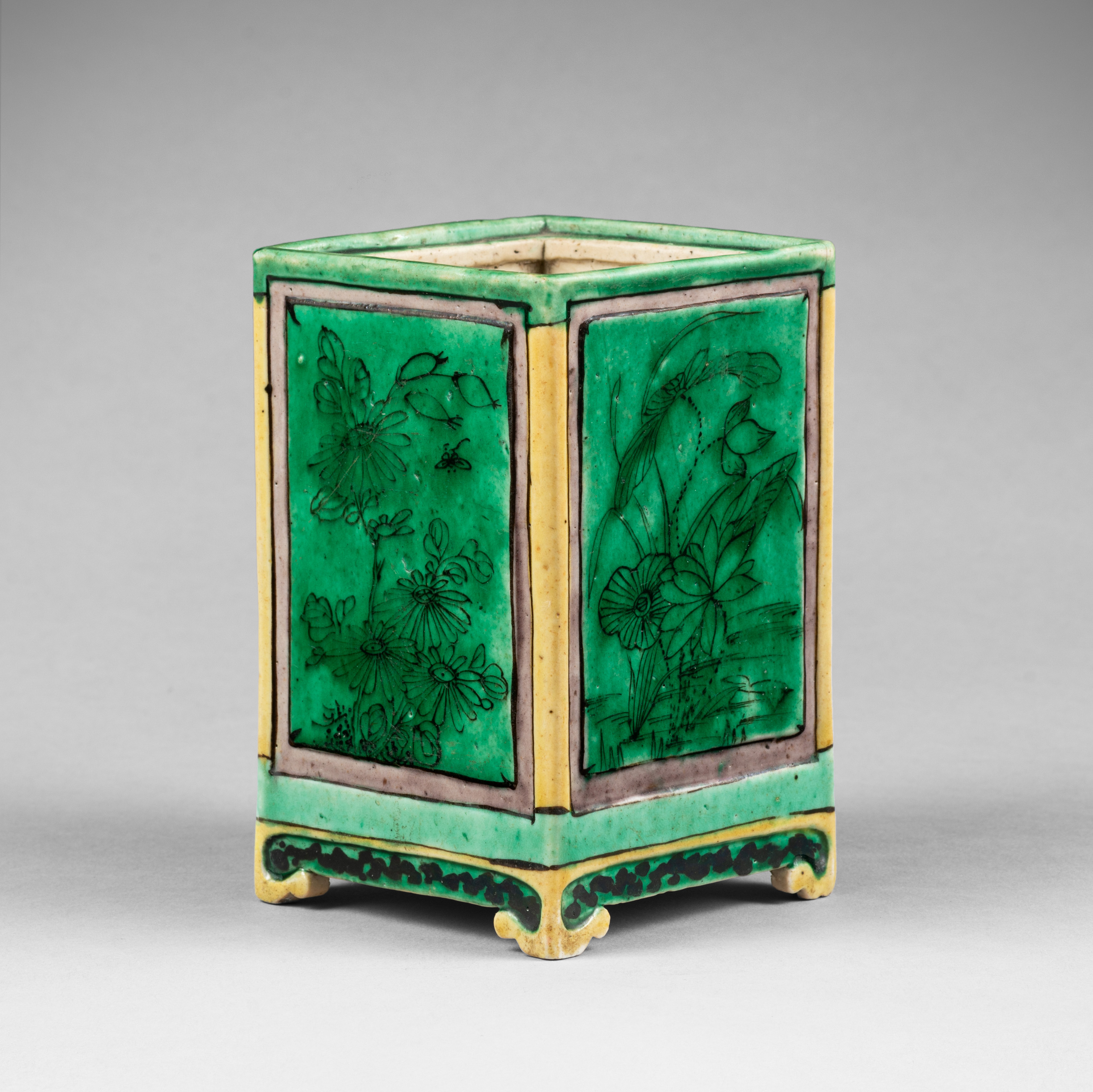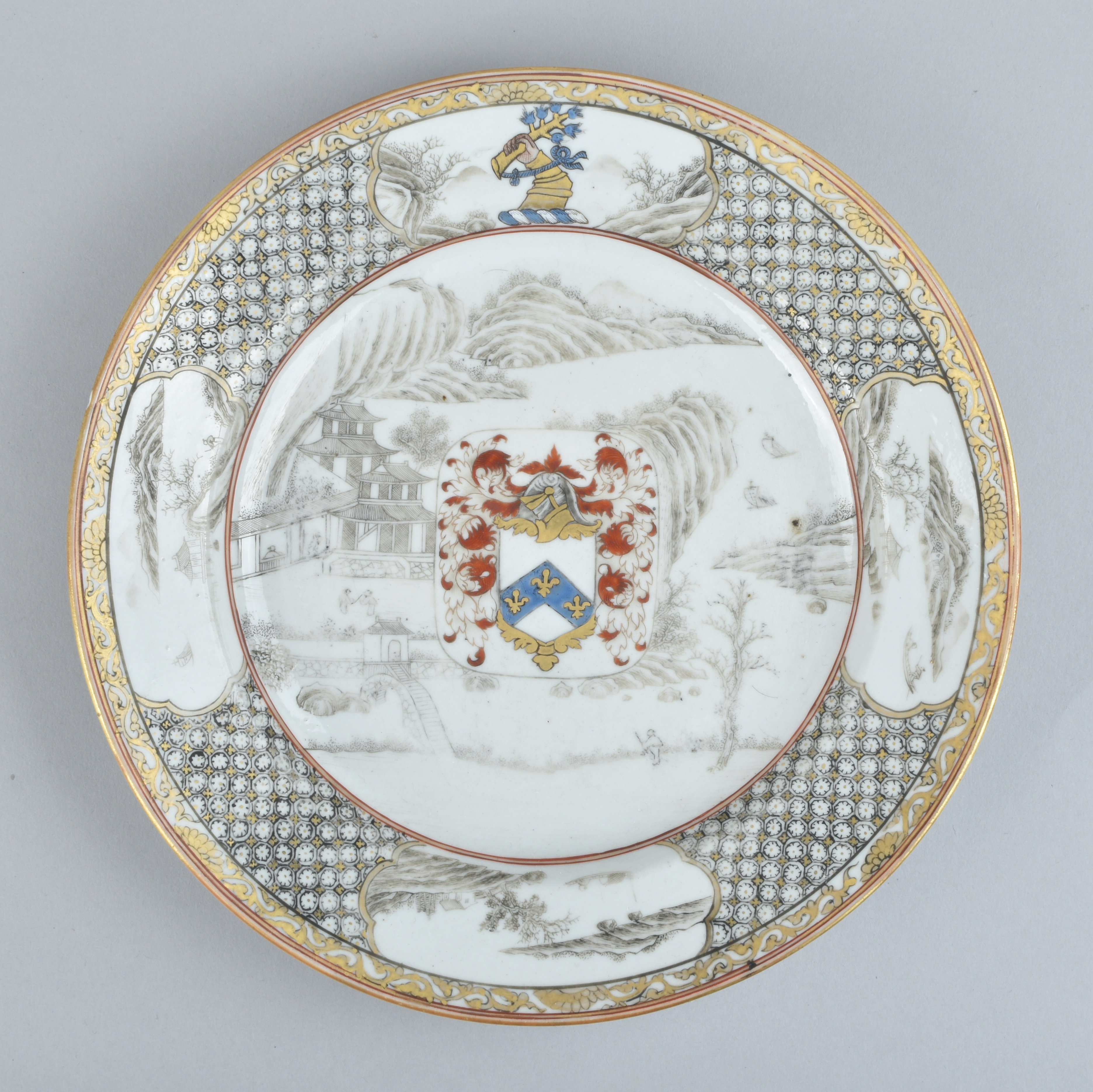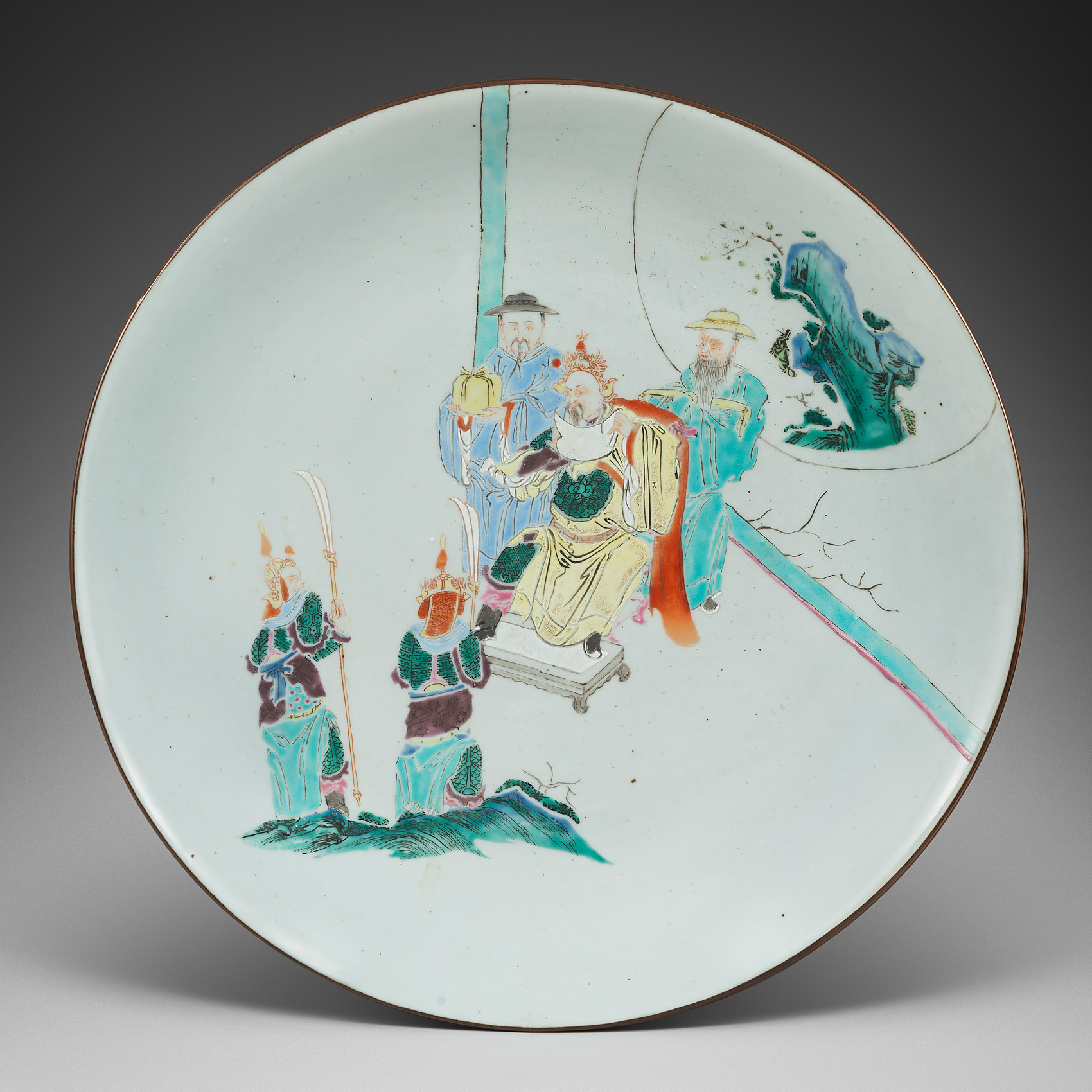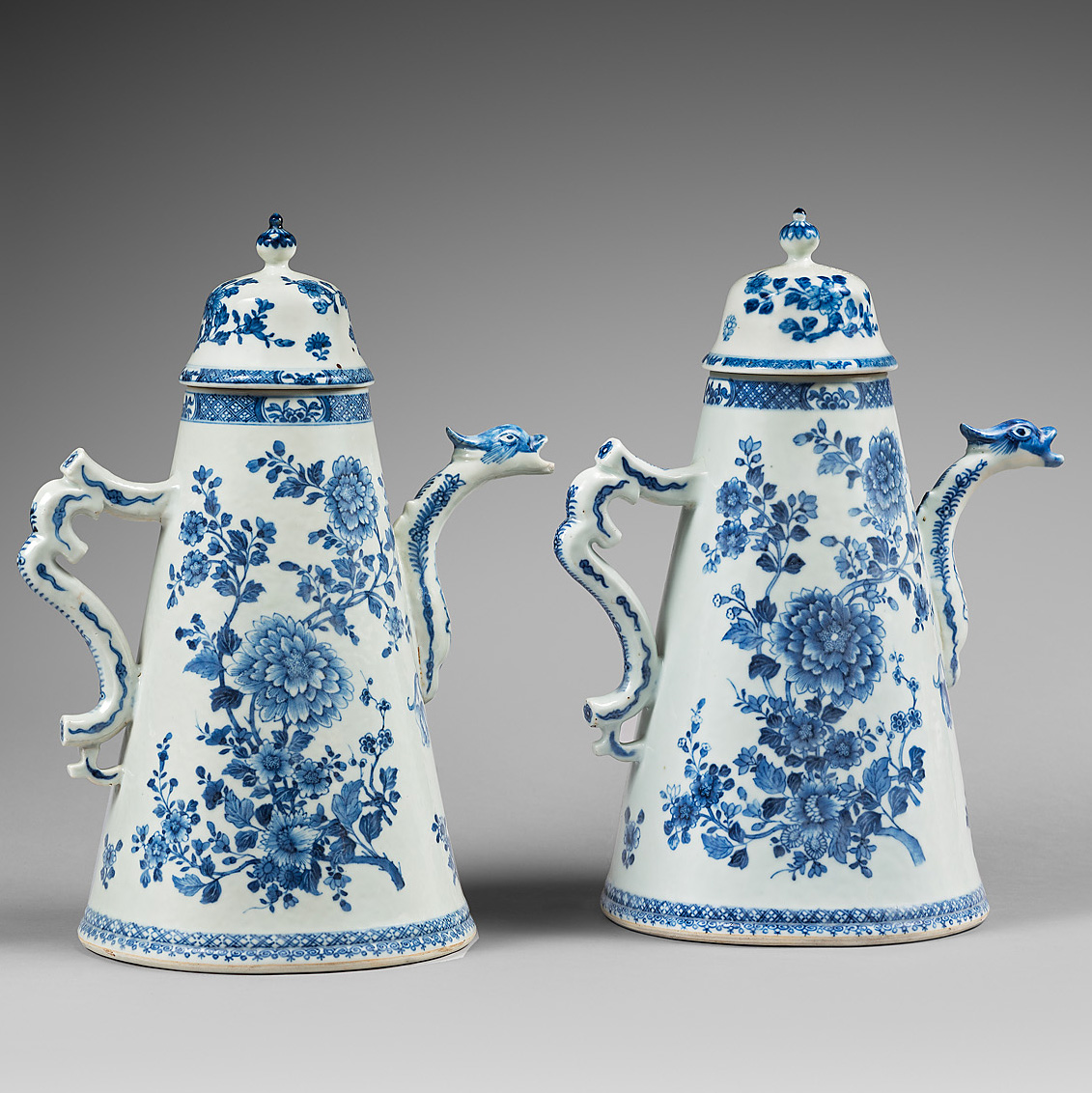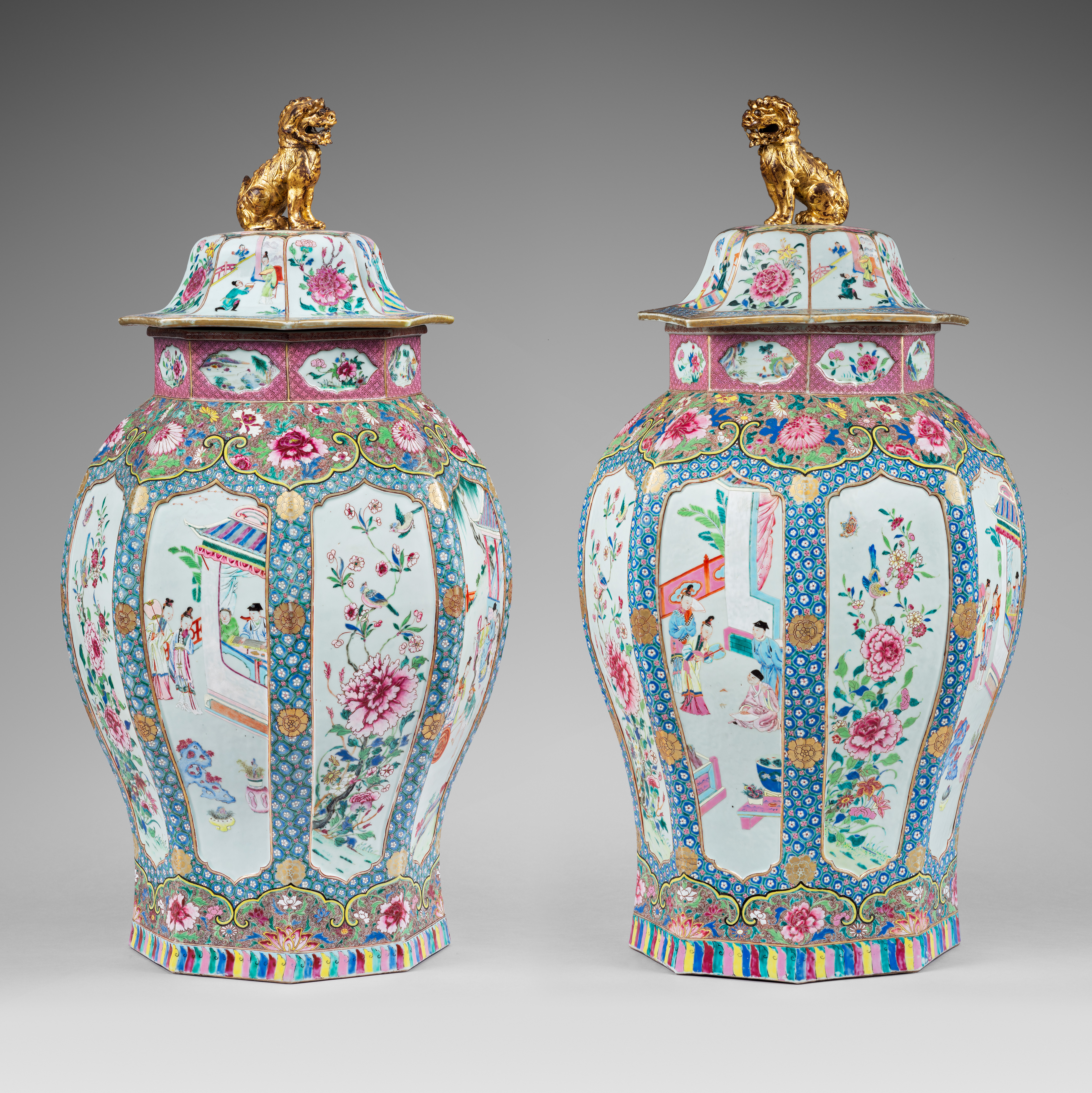
The Alfonso Cumberbatch vases. China, Yongzheng period
Of baluster form, each shaped panel finely enameled with figures at leisure on a pavilion terrace, alternating with butterflies in flight and birds perching on entwined flowering branches, reserved on a blue cell-pattern ground with gilt flower-heads, between ruyi bands at the shoulder and foot with flower sprays on a dense scroll ground, the neck with quatrefoil cartouches enclosing seascapes and peonies reserved on a pink trellis ground, the covers similarly decorated with gilt biscuit seated Buddhistic lion finials.
Reproduced by George Williamson in The Book of Famille Rose, Charles E. Tuttle, 1927, Plate LV.
Photography : Jérémie Beylard / Agence PHAR
- Country:
- China
- Period :
- Yongzheng (1723-1735)
- Material:
- Porcelaine
- Dimension:
- 35,03 in.(88 cm)
- Reference :
- D712
- Status:
- sold
Provenance
Dr. Alfonso Elkin Cumberbatch (1847-1929),
Probably Franck Dickinson, London (dealer), 1919,
From an important European Collection
Related works
Two others pairs with the same decoration are known :
Christie’s London, Fine Chinese Ceramics and Works of Art, 29 november 1971, lot 95 (mistakenly sold as the Cumberbatch), then, Christie’s London, Chinese ceramics and works of art, 06 april 1998, lot 134 (Property of a lady)
Sotheby’s Paris, A Travers les Style: A Private Collection of Silver, Painting and furniture, 15 December 2010, lot 81 (sold as Qianlong period
For related vases, see :
Jorge Welsh, The Vases of the Hundred Treasures, Jorge Welsh Research & Publishing, 2019
A pair of vases decorated with figures, without covers, are in the collections of the Hermitage Museum (Saint-Petersburg), and reproduced by Tatiana Arapova in Chinese Export in the Hermitage Museum, Late 16th – 19th centuries, 2003, p. 30, no. 26.
A pair of vases decorated with figures, (however, the vertical panels are divided in two horizontal parts), published by Cohen & Cohen in Bedtime stories, 2004, no. 5.
Notice
In the art world, there are mythic and unlocalized pieces known through reference books that collectors, amateurs and dealers dream of encountering. The Cumberbatch Vases belong to this category, and our excitement had been huge when we first discovered them in a European private collection three years ago.
We “knew” the vases for a long time as they are reproduced in The Book of Famille Rose par George Williamson, a book dedicated to Famille Rose Chinese Porcelain of the Yongzheng period – still considered the reference book on this topic almost a century after its first publication.
In his book, George Williamson had been very choosy as he illustrated less than ten vases. In this book, the most prestigious Anglo-Saxon provenances are mentioned such as Grandidier, Martin Hurst, Ronald Grevillle, Philip Sassoon, Hugh Morrison … and Cumberbatch.
The Cumberbatch Vases presented at the Pagode CT Loo during the Printemps Asiatique are exceptional: their presence and decorative power are extraordinary; their dimensions demonstrate a technical tour-de force in the first third of the 18th century; their provenance is one of the greatest; the quality of execution of the wide palette of colors and of the talent of the painters in charge of the décor.
The shape and the quality of the Cumberbatch Vases remind « The Vases of the Hundred Treasures » about which Luisa Vinhais and Jorge Welsh wrote that they “appear to be the finest and most exceptional export baluster vases of the period so far recorded.”
That kind of vase was the most desirable porcelain pieces and were commissioned by private orders or executed by the most talented artisan for the most important amateurs. The rediscovery of the Cumberbatch Vases is thus an event in itself.
Throughout our research, we faced an issue. Indeed, the Cumberbatch Vases were supposed to have been sold twice on the art market in London: the first time in 1971 when a German collector acquired them, the second time in 1998 when this German collector sold them.
However, a careful visual analysis of the 1971 and 1998 photographs reveals that the aforementioned vases were the same model, but definitely not the vases from the Cumberbatch Collection. The mistake made in 1971 comes probably from the assumption that this pair of vases was unique. The mistake repeated in 1998 is probably due to the reuse of information from the 1971 catalogue.
The visual analysis of photographs from the 1971 and 1998 catalogs reveals undeniable differences with the Cumberbatch Vases, while our pair is identical in all aspect.
First of all, each decorative panel on the body of each vase (and each cover) is unique. None of the decor is repeated on the same vase. Moreover, the unique firing flaws and the different ways with which the motifs have been painted allow the identification of our pair with the Cumberbatch Vases published in The Book of Famille Rose. It is undisputable that the general shape, the edges and the unique small deformation due to the firing – especially the shape of the lid – of our vases match perfectly the Cumberbatch Vases.
The painting on the lids is also noteworthy. Because of the special tilt of the lions, the lids can only be placed in a unique position on the vases. On the left lid of the Cumberbatch Vases, the fence has been hollowed out, whereas the fence visible on left lid of the 1971/1998 vases is merely painted in orange.
Similarly, on the Cumberbatch Vases as well as on our pair, the object hold by the kneeling character is aligned with the building, while the object is projected in the foreground on the 1971/1998 vases.
On our vases and on the Cumberbatch vases, the head of the young Chinese lady touches the architecture. On the contrary, her head is shifted to the right. In consequence, there can be no doubt that our vases are the Cumberbatch Vases/
The octogonal shape of the vases may be due to Japanese influence. Kakiemon ware, made in Arita by the Sakaida family from the second quarter of the 17thcentury onwards, favoured angular forms, perhaps because they were less susceptible to warping in the kiln than circular ones.
The perfect balance between the shape, the way the decor is arranged in the panels to tell a story and the relevance of the selected stories epitomize the genius of the artists who made the vases. The vases have been illustrated with stories from the Romance of the Western Chamber – the figurative style was the most prestigious and the most desirable style within the genre hierarchy before representation of animals, landscapes and floral motives.
In China, at the end of the 12th century, a certain Dong Jieyuan wrote a book in which he compiled existing text variants of popular theatrical plays, romances and ballads recounting a well-known love story. It was published as the Xixiangji zhugongdiaoi (The Story of the Western Wing in All keys and Modes). In turn, this book was adapted and expanded by Wang Shift (c. 1250-1300), a playwright, who published it as a comedy play in eight books, called the Xixiangji (The Romance of the Western Chamber). Although the Xixiangji entered the realm of classical Chinese literature, the story itself remained immensely popular among all classes in China. Even as recently as the 1980’s Peking opera companies still staged performances, movies were made and even comics used the theme. Without exaggeration it can be stated that the Xixigji is an essential part of China’s oral, literary and theatrical heritage.
Because the story was so popular in China, the most important scenes became conventionalized images and were easily recognized by the public. Woodblock illustrations in the many editions also concentrated on core scenes, thus creating a corpus of motifs that was widely used by painters, silk embroiderers, lacquer workers and other craftsmen.
Porcelain decorated with “The Romance of the Western Chamber” became a widespread fashion in the Shunzi period (1644-61). These porcelains heralded its popularity on the Kangxi period (1662-1722) on famille verte and blue and white wares, when these depictions were not only produced for the domestic Chinese market but were also exported to Europe.
After the suppression of the Ming rebellions (1683), porcelain decorations with hidden political messages and allusions to the “good old Ming times” were unwelcome. The “innocent” Romance of the Western Chamber proved to be an ideal source of motifs and seems to have been more popular than any other theatrical scenes or literary stories.
Most of the Kangxi (1662-1722) and Yongzheng (1723-1735) porcelains illustrating the Romance of the Western Chamber depict only one episode of the play, and porcelain embellished with several scenes form the play are very seldom. For instance, a large bowl and a large dish, both painted with Famille verte enamels – our gallery has recently presented a beautiful example, a large bowl painted in underglaze blue (Sotheby’s New York, Kangxi : The Jie Rui Tang Collection, 20 march 2018, lot 631) and a vase-rouleau from the Victoria and Albert Museum in London (C.859-1910).
The iconographic program had been defined to embellish each face of the vases as well as their lids alternating with floral motifs sometimes complemented with birds and butterflies, symbol of emotion. Among the eight episodes form the Romance of the Western Chamber that had been selected to decorate the vases, only seven have been identified thanks to Christiaan Jörg’s book, Famille Verte: Chinese Porcelain in Green Enamels – unfortunately, one scene remains unidentified.
Scene 1: Zhang on horseback travelling to the capital. His servant is walking and carries his master’s belongings, including a pile of books on a pole on his shoulder. Zhang wears a scholar’s cap to distinguish him.
Scene 3: Zhang is shown around by his attendant. He sees Yingying and Hongniang strolling outside, and although Yingying keeps her fan high in a modest gesture to hide her face, Zhang falls in love.
Scene 12: Hongniang takes Zhang outside to play the zither for Yingying.
Scene 13: Zhang, behind a wall in his room, plays the zither for Yingying, who Hongniang has taken outside. The act is set at night, and the scene take place under the stars.
Scene 16: Zhang, having read Yingying’s answer, rushes to meet her in the garden, supporting himself on a willow branch as he leaps a wall. Yingying turns away, angry at his uncouth behaviour.
Scene 20: Zhang departs for the capital to sit his examinations and bids farewell to Yingying and Hongniang. His sedan-chair stands ready, his servant prepares the luggage.
Scene 22 : Zhang’s servant brings new’s of his master to Yingying and Hongniang. He passed his examinations but has fallen ill and is delayed. He holds her letter in his hands.
The idea of defying parental will in the name of love, in addition to the occasionally suggestive, licentious content, made The Romance of the Western Chamber a target of censorship at various times, including during the early part of the Qianlong period, quite soon after the realization of those vases. Nevertheless, the story continued to enjoy popularity and scenes from it were retold in various formats, from paintings to decoration on lacquerwares and ceramics.
Photography : Jérémie Beylard / Agence PHAR


